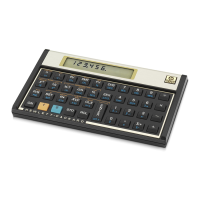Appendix A: RPN and the Stack 169
Pressing d four times successively displays the numbers in the Y-, Z-, and
T-registers and returns the numbers to their original registers.
One-Number Functions and the Stack
One-number mathematics and number-alteration functions – y, r, ¿ >,
’, e, B, Ñ, and T – use only the number in the displayed X-register.
When the key is pressed, the function is performed upon the number in the
X-register, and the answer is then placed into the X-register. The stack does not
lift, so the number formerly in the X-register does not get copied into the Y-
register; but this number is copied into the LAST X register. The numbers in the
Y-, Z-, and T-registers are not affected when a one number function is per-
formed.
Two-Number Functions and the Stack
Two-number functions – +, -, §, z, q, b, à, and Z – use the
numbers in both the X- and the Y-registers.
Mathematics Functions
To perform an arithmetic operation, the numbers are positioned in the X- and
Y-registers just as you would write them vertically on paper: the number you
would write on top goes in the Y-register, and the number you would write on the
bottom goes in the X-register. For example, to do each of the four arithmetic
calculations shown below, you would put the 8 in the Y-register (using \ and
then key the 2 into the displayed X-register.
Keys
Ke y

